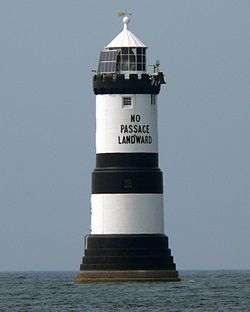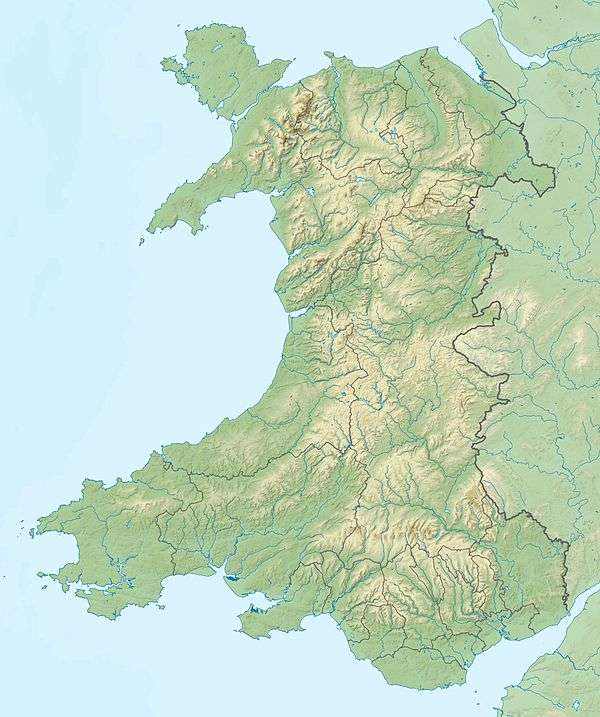Trwyn Du Lighthouse
 Trwyn Du Lighthouse | |
 Wales | |
| Location |
Penmon Anglesey Wales United Kingdom |
|---|---|
| Coordinates | 53°18′47″N 4°02′26″W / 53.312994°N 4.040630°WCoordinates: 53°18′47″N 4°02′26″W / 53.312994°N 4.040630°W |
| Year first constructed | 1838 |
| Automated | 1922 |
| Construction | stone tower |
| Tower shape | cylindrical tower with balcony and lantern |
| Markings / pattern | white and black bands tower, white lantern |
| Height | 29 m (95 ft) |
| Focal height | 19 m (62 ft) |
| Current lens | 1st Order catadioptric fixed |
| Intensity | 3,088 candela |
| Range | 12 nmi (22 km) |
| Characteristic | Fl W 5s. |
| Fog signal | bell stroke once every 30s. |
| Admiralty number | A5140 |
| NGA number | 5420 |
| ARLHS number | WAL-031 |
| Managing agent |
Trinity House[1] [2] |
| Heritage |
Grade II* listed building |

Trwyn Du Lighthouse is a lighthouse between Black Point near Penmon and Ynys Seriol, or Puffin Island, at the eastern extremity of Anglesey, marking the passage between the two islands.
History
The first lighthouse was erected in 1838, at a price of £11,589. There had been a call for a light at this location for some years by master shipmen in the nearby city of Liverpool especially after the steamer the Rothsay Castle ran aground and broke up nearby in 1831 with 130 people losing their lives.[3]
The present Lighthouse is 29m tall and was designed by James Walker and built in 1835-1838. It was his first sea-washed tower, and a prototype for his more ambitious tower on the Smalls.
The Lighthouse has a stepped base designed to discourage the huge upsurge of waves that had afflicted earlier lighthouses on the site and reduce the force of the water at the bottom of the tower.
Austere vertical walls, instead of the usual graceful lines of other rock towers, are probably an economy measure. The tower has a crenellated stone parapet, in preference to iron railings on the gallery, and narrows in diameter above the half-way point. These are a features used by Walker in his other lighthouse designs. The tower is distinguished by its original three black bands painted on a white background. Its also bears the words "NO PASSAGE LANDWARD" on its north and south side.
Walker also pioneered, unsuccessfully, the use of a primitive water closet, comprising a specially designed drain exiting at the base of the tower. The stepped design of the lighthouse may have helped water exit the closet, but surges of seawater made its use difficult during heavy weather.
One of the many Lighthouse keepers was Joseph Steer, born in 1831 at Bovey Tracey, Devon.(source UK census of 1881) More details of the lighthouse can be found at http://www.penmon.org/page6.htm
Modernisation
The lamp was converted to solar power in 1996 and the lighthouse was modernised extensively at that time.
At present the Lighthouse has a 15,000 candela light that flashes once every 5 seconds and can be seen 12 nmi (22 km) away, as well as a 178 kilogram fog bell that sounds once every thirty seconds.[4] There was also a lifeboat station built in 1832, nearby, but this closed in 1915.
The tower has been unmanned since 1922 and is checked from Holyhead Control Centre.
Access and facilities
Penmon Point is accessible by heading east out of Beaumaris and through Llangoed. For a small fee you can go along a toll road and park very close to the lighthouse or park for free about a mile from the lighthouse. The area around Dinmor contains a cafe, shop and toilets[5] and is good for fishing.
See also
References
- ↑ Trwyn Du The Lighthouse Directory. University of North Carolina at Chapel Hill. Retrieved 3 June 2016
- ↑ Trwyn Du Lighthouse Trinity House. Retrieved 3 June 2016
- ↑ An Anglesey Today article on the lighthouse
- ↑ Trwyn Du on the Trinity House website Archived 17 August 2008 at the Wayback Machine.
- ↑ Trwyn Du on the Beach Guide Wales website
Sources
- Hague, D., B., The Lighthouses of Wales Their Architecture and Archaeology (The Royal Commission on the Ancient and Historical Monuments of Wales, Edited by Hughes, S., 1994) ISBN 1-871184-08-8
External links
| Wikimedia Commons has media related to Trwyn Du Lighthouse. |